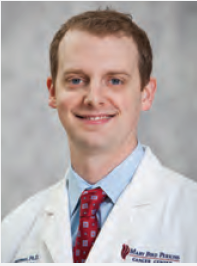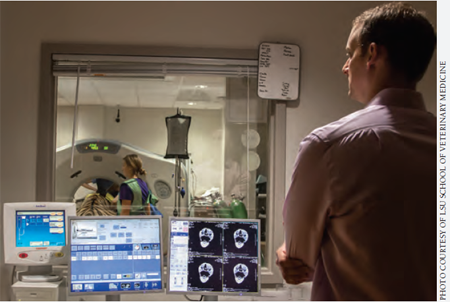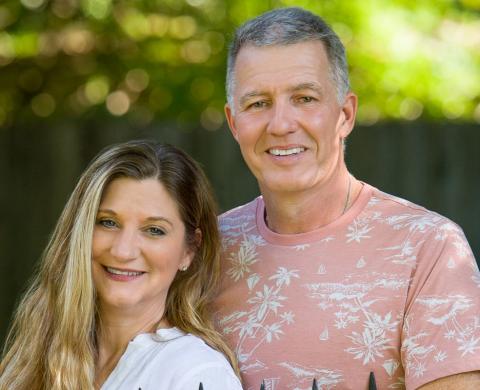Medical physicist coordinates measured assault on cancer
(La Louisiane Fall 2016/Winter 2017 p. 39)
 Dr. Jonas Fontenot
Dr. Jonas Fontenot
(Bachelor of Science in physics 2002)
When LSU's tiger mascot, Mike VI, was taken to Mary Bird Perkins - Our Lady of the Lake Cancer Center last summer for treatment, Dr. Jonas Fontenot orchestrated his care. Fontenot is chief of medical physics there. A medical physicist is a scientist who collaborates with physicians, neurologists, specialty nurses and others to provide tailored doses of radiation therapy to patients.
The Bengal/Siberian tiger mix was diagnosed in May 2016 with spindle cell carcinoma, which is incurable in humans. He may have been the first tiger to be diagnosed with that cancer; he is believed to be the first to undergo radiation therapy for it. He was treated at the Cancer Center on June 1, after regular business hours.

Dr. Jonas Fontenot oversaw Mike VI's radiation treatment.
Veterinarians hoped to prolong Mike VI's life from a week or two to a year or more. But he was euthanized five months later, when they determined that the cancer had spread.
As a UL Lafayette freshman from Crowley, La., Fontenot thought he wanted to become a civil engineer. However, a chance encounter with Dr. Louis Houston, a former University physics faculty member, put him on a career path that ultimately led him to the Cancer Center. Fontenot was a student working part-time at a produce stand when he met Houston, who was shopping there. "Dr. Houston started telling me about physics in a little more detail, about the problems physicists are interested in solving and their approach to solving them. It really appealed to me," Fontenot recalled in a recent interview.
After talking with some other UL Lafayette faculty members, Fontenot changed his major to physics. He was a junior when he began to contemplate what career a physics degree would enable him to pursue. Dr. John Meriwether, a UL Lafayette physics professor who is now retired, introduced him to Danny Landry of Lake Charles, La., who had studied medical physics after earning a bachelor's degree in physics from USL. After learning more about medical physics from Landry, Fontenot was hooked.
He went on to receive a bachelor's degree in physics. Fontenot completed a summer internship at the University of Texas at Houston cyclotron laboratory, which produces medical isotopes, before entering graduate school. He earned master's and doctoral degrees from the University of Texas M.D. Anderson Cancer/Graduate School of Biomedical Sciences at Houston in 2005 and 2008, respectively.
Fontenot soon joined the Cancer Center, where he held several positions before being named its chief of medical physics in 2015. He recently helped integrate a new piece of equipment, the Leksell Gamma Knife IconTM, at the center. It's used primarily to treat diseases of the brain – regardless of whether they are cancerous. "Although it's got the word 'knife' in the title, it's actually noninvasive, using radiation. You get the precision of the surgeon's scalpel and through the use of very large doses of radiation, you're able to completely eliminate diseased tissue," he said. "It takes an entire array of physicians from different backgrounds to be able to use the device to its maximum capabilities," he continued. It also takes a strong medical physics team. "The tissues in your body always remember how much radiation they received. So, if you don't get it right the first time, it's difficult or impossible to go back and do it again."



 Dr. Jonas Fontenot
Dr. Jonas Fontenot